Hairpin Juniper
+7
Peter Thorne
Jaco Kriek
mike Bat
JimLewis
Vance Wood
Stone Monkey
fiona
11 posters
Page 1 of 1
 Hairpin Juniper
Hairpin Juniper
About 2 years ago I posted this pic on the old site.
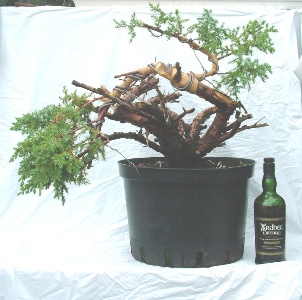
It was a juniper that I had reclaimed from the garden and its biggest problem was that it had a vicious hairpin bend in it - mostly, I'm sure, because it was under the bird table and had been used as a step-ladder by a scavenging labrador.
At the time my good friend Len Gilbert and I decided to use it as a project tree on which I could hone a few skills without fear of destroying something valuable. Here is its journey:
1. the original tree as dug up. Not much to go with but it was free (I'm Scottish remember!)
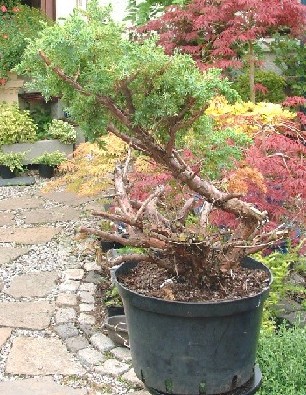
The original pic on the old site was taken after the first attempt at shaping the tree. There were two useable branches coming off the one main branch. Everything else was ditched.
2. at Willowbog winter 2007-2008. At this point the plan was to have a jin sticking up and the deadwood at the back of the tree
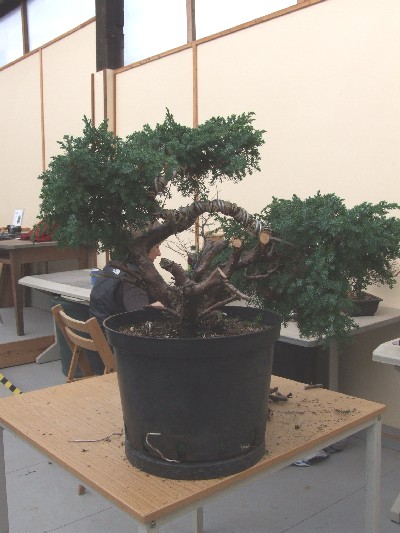
3. Len pulls the jin branch up through the tree
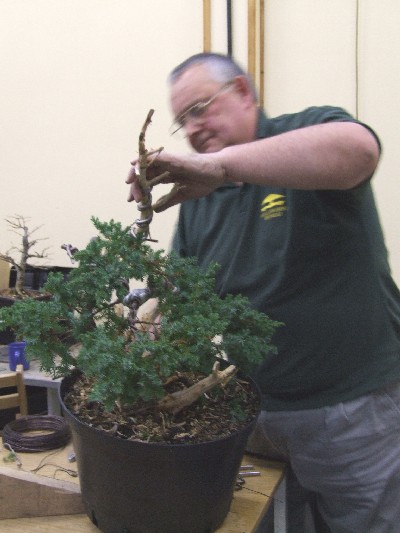
4. The tree was essentially left for a full year (i.e. forgotten about!) until two weeks ago when I went on a carving workshop and wanted something to practise on. This is it before I launched off into a carve frenzy. You can see that the jin has gone by now - partly because I kept stabbing myself with it but also, I couldn't at this point really see where the tree was going with the front we had designated.
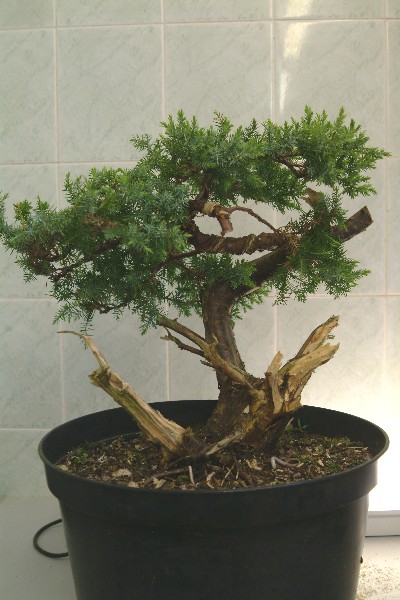
5. Decision made - the old front is now the back and the deadwood is now at the front of the tree.
The shape is radically different from what was originally planned, mostly because one of the main branches had split away and really wasn't going to hang on for much longer.
Anyway here is the current state of play.

There is still a long way to go, and I am under no illusions that this is ever going to be a prize-winner. It has however fulfilled its purpose as a training project tree and along the way I have learned to overcome natural flaws (eg the hairpin, the split branch), overcome man-made flaws (I left wire on for far too long and it cut in) and I have learned a bit about deadwood and carving. To that end I'm happy - skills learned, nothing damaged and a tree I'm happy enough with.
Oh and to bring things full circle - here's a pic with the Ardbeg bottle back in (no, it's not the same one!)
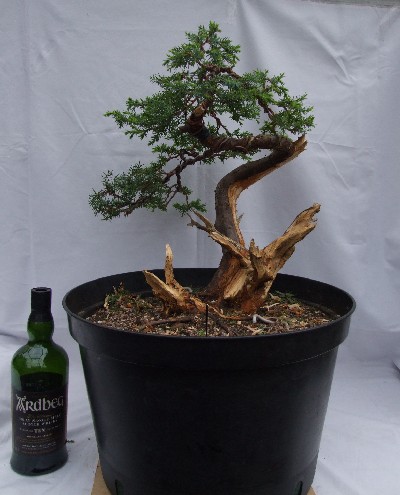

It was a juniper that I had reclaimed from the garden and its biggest problem was that it had a vicious hairpin bend in it - mostly, I'm sure, because it was under the bird table and had been used as a step-ladder by a scavenging labrador.
At the time my good friend Len Gilbert and I decided to use it as a project tree on which I could hone a few skills without fear of destroying something valuable. Here is its journey:
1. the original tree as dug up. Not much to go with but it was free (I'm Scottish remember!)

The original pic on the old site was taken after the first attempt at shaping the tree. There were two useable branches coming off the one main branch. Everything else was ditched.
2. at Willowbog winter 2007-2008. At this point the plan was to have a jin sticking up and the deadwood at the back of the tree

3. Len pulls the jin branch up through the tree

4. The tree was essentially left for a full year (i.e. forgotten about!) until two weeks ago when I went on a carving workshop and wanted something to practise on. This is it before I launched off into a carve frenzy. You can see that the jin has gone by now - partly because I kept stabbing myself with it but also, I couldn't at this point really see where the tree was going with the front we had designated.

5. Decision made - the old front is now the back and the deadwood is now at the front of the tree.
The shape is radically different from what was originally planned, mostly because one of the main branches had split away and really wasn't going to hang on for much longer.
Anyway here is the current state of play.

There is still a long way to go, and I am under no illusions that this is ever going to be a prize-winner. It has however fulfilled its purpose as a training project tree and along the way I have learned to overcome natural flaws (eg the hairpin, the split branch), overcome man-made flaws (I left wire on for far too long and it cut in) and I have learned a bit about deadwood and carving. To that end I'm happy - skills learned, nothing damaged and a tree I'm happy enough with.
Oh and to bring things full circle - here's a pic with the Ardbeg bottle back in (no, it's not the same one!)


fiona- Member
 Re: Hairpin Juniper
Re: Hairpin Juniper
Fiona
Thats a very very nice....bottle of single malt there, feed it well
The tree is coming on very well too
All the best from down South
Andy
Thats a very very nice....bottle of single malt there, feed it well
The tree is coming on very well too
All the best from down South
Andy

Stone Monkey- Member
 Re: Hairpin Juniper
Re: Hairpin Juniper
Stone Monkey wrote:Thats a very very nice....bottle of single malt there, feed it well
Sadly, it's also a very very empty bottle of single malt
I should have added on the last post that I am always glad to hear comments about how this tree can progress. I'd be especially interested in whether people think the branch going off down to the left (as we look at it) should go - i.e. should the balance be really in the other direction as someone has already suggested. Obviously the tree needs to rest and regrow a bit more foliage, so I'm keen to grow it in the right place.
Cheers
Fiona

fiona- Member
 Re: Hairpin Juniper
Re: Hairpin Juniper
fionnghal wrote:Stone Monkey wrote:Thats a very very nice....bottle of single malt there, feed it well
Sadly, it's also a very very empty bottle of single malt
I should have added on the last post that I am always glad to hear comments about how this tree can progress. I'd be especially interested in whether people think the branch going off down to the left (as we look at it) should go - i.e. should the balance be really in the other direction as someone has already suggested. Obviously the tree needs to rest and regrow a bit more foliage, so I'm keen to grow it in the right place.
Cheers
Fiona
I think your personal criticism of the tree's future is wrong. It has great lines, good branch arrangement and a very interesting base. It just need refinement and a good pot. I think it could do well in just about any show anywhere. The time line development you have documented is a very good study in design, a remarkable example of leaving options open and responding by the seat of the pants when a new idea reveals itself. Is this a good tree? No,---- don't be satisfied with good. This could be a great tree.
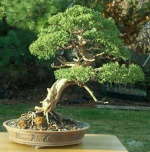
Vance Wood- Member
 Re: Hairpin Juniper
Re: Hairpin Juniper
Stone Monkey wrote:Thats a very very nice....bottle of single malt there, feed it well
Sadly, it's also a very very empty bottle of single malt Sad
Well, it sure took you long enough to drink it! How much time passed between picture # 1 and the last one? <g>
I think I'm gonna like this tree after maybe three more bottles.

JimLewis- Member
 Re: Hairpin Juniper
Re: Hairpin Juniper
[quote="JimLewis"]
Only in England would it take a full two years to drink one wee tiny bottle of Ardbeg - unless of course you're Tony Tickle who I seem to remember trying to down an entire one on the Saturday of a Burrs event. Interesting colour the next day! Up here where men are men even if they do wear skirts, we drink a bottle each day - for breakfast!
Thanks for the kind words, Vance. I wasn't at all convinced when my colleague suggested putting the foliage down the other side. It seemed to make it go in two different directions at once. I'm happy to stick with the direction it's going in just now.
Jim, I like the tree after only one glass never mind three bottles, not because I think it is a show stopper - Vance is more than kind on that front - but because it's the first full project I've attempted on something collected (albeit from not very far away) and I've had a chance to develop better skills along the way. To me that's a match win bonus.
I feel I wasted three or four years at the beginning of my bonsai life working with the sort ofs**** garbage you get from garden centres and malls. Without meaning to offend anyone, I've noticed a quantity of similar material on display of late on this site, and if posting a pic or two here of something I've done which uses a salvaged garden tree as practice material with a decent enough result can help save anyone from those early years of working on duff material then I'm happy. I'm not saying this tree is good, I'm merely saying I personally think it was a more beneficial exercise than can be achieved from buying and working on the rubbish they sell in garden centres, marketed as "quality bonsai".
Sorry for the rant.
Well, it sure took you long enough to drink it! How much time passed between picture # 1 and the last one? I think I'm gonna like this tree after maybe three more bottles.
Only in England would it take a full two years to drink one wee tiny bottle of Ardbeg - unless of course you're Tony Tickle who I seem to remember trying to down an entire one on the Saturday of a Burrs event. Interesting colour the next day! Up here where men are men even if they do wear skirts, we drink a bottle each day - for breakfast!
Thanks for the kind words, Vance. I wasn't at all convinced when my colleague suggested putting the foliage down the other side. It seemed to make it go in two different directions at once. I'm happy to stick with the direction it's going in just now.
Jim, I like the tree after only one glass never mind three bottles, not because I think it is a show stopper - Vance is more than kind on that front - but because it's the first full project I've attempted on something collected (albeit from not very far away) and I've had a chance to develop better skills along the way. To me that's a match win bonus.
I feel I wasted three or four years at the beginning of my bonsai life working with the sort of
Sorry for the rant.

fiona- Member
 Re: Hairpin Juniper
Re: Hairpin Juniper
i really like you tree ... to be honist i didnt see much in the first picture ,,, but that last pic i see one killer tree ... good job
mike Bat- Member
 Re: Hairpin Juniper
Re: Hairpin Juniper
Ask anyone who knows me, I do not throw complements around generously and without reason. I think this tree has great potential and I fear, in your effort to be humble about your efforts, you may allow a really good tree to languish or decline because you think you can find better material somewhere else. Good material is where you find it, the real talent is in recognizing it when it happens. Don't buy into the myth that it is impossible to find good "stuff" in a nursery. It is not anymore difficult than finding good stuff on a mountain top. Both take effort and a good eye and the realization that not everything you see is good stuff whether it is a two-hundred year old POS with no redeeming artistic merit or a twenty-five year old nursery tree. The good stuff, regardless of where you find it, takes looking over a lot of things, most of which you will or should reject.

Vance Wood- Member
 Re: Hairpin Juniper
Re: Hairpin Juniper
Thanks Vance. I have no intention of letting the tree languish - it is a project tree and I want to see it through to completion as it is far from being a finished item at the present. I am pleased with the result so far - mostly because it has allowed skills development, but aesthetically too it has exceeded my expectations and that is a major plus and shows me maybe I do have a bit of an "eye" for this craft of ours.
And of course you are right about there being good stuff in a nursery if you know where and more importantly how to look. The point I was trying to make is that, like many others, I spent a number of years working with quite definitely inferior material partly because of a lack of knowledge and understanding of what bonsai actually is. Again like many others, my introduction to bonsai was through the bog-standard low-end mallsai sold in UK garden centres that are being passed off as "quality bonsai" but which most of us recognise as the standard mass-produced stuff designed for the export market and shipped across the world to be sold in garden centres and malls in the western world to people who know little about bonsai. A number of trees in this category are appearing on this forum and while we should not be trying to denigrate the trees or the novice owners (who are genuinely interested in and enthusiastic about their new hobby), I would like to think that we could give a gentle nudge to point them in the direction of what looking around a bit more could do. They have by and large bought trees which cannot be improved on to any real effect. I wish I had been given advice along those lines 7 years ago when I started - that way I would have been able to recognise the potential of the twisted bit of juniper under my bird table a lot sooner and I wouldn't have wasted time and money on inferior trees that unscrupulous traders had tried to pass of as quality.
I'm aware that this all sounds colossally snobbish and that I might come across as my passing myself off as some sort of expert. Please accept it is not an attempt to be so. I am still a relative beginner and I too bought mallsai. I really only want to draw the attention of other novices to the potential for wasted time, effort and money when there is better material to be worked on if you know how to look. Surely a principal (and good) use of this forum is to help and encourage novices and I fear we may be failing in that on occasion. That's why I posted about the juniper - not to get a lot of back-slapping comments about how brilliant I am (or am not as the case may be!) but to show what can be done by a relative beginner on material with potential that is a step or three up from mallsai but which probably only cost me about £10 when I bought the original tree.
And of course you are right about there being good stuff in a nursery if you know where and more importantly how to look. The point I was trying to make is that, like many others, I spent a number of years working with quite definitely inferior material partly because of a lack of knowledge and understanding of what bonsai actually is. Again like many others, my introduction to bonsai was through the bog-standard low-end mallsai sold in UK garden centres that are being passed off as "quality bonsai" but which most of us recognise as the standard mass-produced stuff designed for the export market and shipped across the world to be sold in garden centres and malls in the western world to people who know little about bonsai. A number of trees in this category are appearing on this forum and while we should not be trying to denigrate the trees or the novice owners (who are genuinely interested in and enthusiastic about their new hobby), I would like to think that we could give a gentle nudge to point them in the direction of what looking around a bit more could do. They have by and large bought trees which cannot be improved on to any real effect. I wish I had been given advice along those lines 7 years ago when I started - that way I would have been able to recognise the potential of the twisted bit of juniper under my bird table a lot sooner and I wouldn't have wasted time and money on inferior trees that unscrupulous traders had tried to pass of as quality.
I'm aware that this all sounds colossally snobbish and that I might come across as my passing myself off as some sort of expert. Please accept it is not an attempt to be so. I am still a relative beginner and I too bought mallsai. I really only want to draw the attention of other novices to the potential for wasted time, effort and money when there is better material to be worked on if you know how to look. Surely a principal (and good) use of this forum is to help and encourage novices and I fear we may be failing in that on occasion. That's why I posted about the juniper - not to get a lot of back-slapping comments about how brilliant I am (or am not as the case may be!) but to show what can be done by a relative beginner on material with potential that is a step or three up from mallsai but which probably only cost me about £10 when I bought the original tree.
Last edited by fionnghal on Fri Jun 12, 2009 7:33 am; edited 1 time in total

fiona- Member
 Re: Hairpin Juniper
Re: Hairpin Juniper
Fiona has touched on quite a few points (none more so than my single malt drinking capacity)
Every bonsai practitioner (I use this word carefully) must decide on what ‘level’ they want to achieve in the art of Bonsai. Clearly Fiona is aiming high, and by this target the ‘hairpin juniper’ will never be a great bonsai.
Bonsai starts with what material you have available: grow your own from seeds or cutting, Garden centre/nursery stock, yamadori both Garden and ‘wild’. Then there is the point of ‘how long have you got to achieve the result you want’.
I do not hold with the traditional notion that bonsai artists must have a ‘right of passage’ that being… working on cheap nursery material, moving on to better, then going for the ‘serious stuff’.
What is true is that in a very short time frame (measured in years) and in the hands of a competent artist raw material can make very ‘credible’ bonsai with all the maturity, refinement and artistic merit one would associate with a prize winner.
What is also true is that almost every bonsai artist I have met proclaims that they wasted too much time, energy and money on ‘Rubbish’ the early years of their ‘career’
So... how does a ‘beginner’ not make the same mistake (as Fiona is stating?)
1. If you are in a bonsai club and the highlight of the meeting is the tea and biscuits GET OUT as fast as you can. Traditional bonsai clubs are NOT a route to excellence in bonsai, you will have a lot of ‘fun’ both social and educational… but great bonsai will not come from being a member of a tea and biscuit ‘club’. Find people who’s aspirations are the same as yours, there is nothing wrong with aiming high… start your own group (I know that Fiona has)
2. Finding Bonsai material is like buying a second hand car, take someone with you who KNOWS what to look for.
3. In the UK you will NEVER find true world class raw bonsai material in a garden centre.
4. If an ‘artist’ is selling the material ask them ‘why’ lets face it most bonsai artists usually keep the best material for themselves.
5. If you are happy to buy good raw material from an artist, get a suggestion of the design they would execute. Even do a workshop with them to achieve that design.
7. Do not simply rely on books or this forum for your inspiration, visit exhibitions, bonsai artist’s gardens and bonsai nurseries.
My good friend and neighbour David Barlow has always worked on good material and within six years of ‘starting’ bonsai he won a Ginkgo Award with a tree he collected himself. Is there anyone on this forum who achieved so much in such a short time?
As Les Brown says “Shoot for the moon and if you miss you will still be among the stars.”














Every bonsai practitioner (I use this word carefully) must decide on what ‘level’ they want to achieve in the art of Bonsai. Clearly Fiona is aiming high, and by this target the ‘hairpin juniper’ will never be a great bonsai.
Bonsai starts with what material you have available: grow your own from seeds or cutting, Garden centre/nursery stock, yamadori both Garden and ‘wild’. Then there is the point of ‘how long have you got to achieve the result you want’.
I do not hold with the traditional notion that bonsai artists must have a ‘right of passage’ that being… working on cheap nursery material, moving on to better, then going for the ‘serious stuff’.
What is true is that in a very short time frame (measured in years) and in the hands of a competent artist raw material can make very ‘credible’ bonsai with all the maturity, refinement and artistic merit one would associate with a prize winner.
What is also true is that almost every bonsai artist I have met proclaims that they wasted too much time, energy and money on ‘Rubbish’ the early years of their ‘career’
So... how does a ‘beginner’ not make the same mistake (as Fiona is stating?)
1. If you are in a bonsai club and the highlight of the meeting is the tea and biscuits GET OUT as fast as you can. Traditional bonsai clubs are NOT a route to excellence in bonsai, you will have a lot of ‘fun’ both social and educational… but great bonsai will not come from being a member of a tea and biscuit ‘club’. Find people who’s aspirations are the same as yours, there is nothing wrong with aiming high… start your own group (I know that Fiona has)
2. Finding Bonsai material is like buying a second hand car, take someone with you who KNOWS what to look for.
3. In the UK you will NEVER find true world class raw bonsai material in a garden centre.
4. If an ‘artist’ is selling the material ask them ‘why’ lets face it most bonsai artists usually keep the best material for themselves.
5. If you are happy to buy good raw material from an artist, get a suggestion of the design they would execute. Even do a workshop with them to achieve that design.
7. Do not simply rely on books or this forum for your inspiration, visit exhibitions, bonsai artist’s gardens and bonsai nurseries.
My good friend and neighbour David Barlow has always worked on good material and within six years of ‘starting’ bonsai he won a Ginkgo Award with a tree he collected himself. Is there anyone on this forum who achieved so much in such a short time?
As Les Brown says “Shoot for the moon and if you miss you will still be among the stars.”















Guest- Guest
 Hairpin Juniper
Hairpin Juniper
I have been reading this story with interest and would like to congratulate Fiona on the improvement in her wiring skills. I was at the carving workshop she referred to and the tree she went away with was nothing like as good as the tree she photographed after the foliage had been wired & placed.
Which brings me onto my contribution, which is this......
A two dimensional picture can only convey one image of the subject and as I recall this tree is quite different (and in my opinion not as good) when viewed from the side. (Perhaps Fiona could post some pictures of the tree taken from the other sides to allow others to comment).
This raises the question of what we mean when we refer to a good tree. Is it a tree that conveys an image of balance, harmony, and proportion when viewed from every angle, or a tree that only exhibits these characteristics when viewed from the preferred front?
The suggested image prepared by Jaco Kriek, certainly shows a studding tree. But what would it look like if the tree was turned round by 90 degrees? I think it is generally accepted that every tree has a best or preferred front. But should we expect that a good Bonsai should be appealing whatever side it was viewed from? My recollection is that the best of the trees exhibited at Birmingham or Ginko looked great from many points of view, and I suggest that before we all get excited by a single picture of a tree, a more robust evaluation could be arrived at if we saw it from many different angles.
What do you think?
Which brings me onto my contribution, which is this......
A two dimensional picture can only convey one image of the subject and as I recall this tree is quite different (and in my opinion not as good) when viewed from the side. (Perhaps Fiona could post some pictures of the tree taken from the other sides to allow others to comment).
This raises the question of what we mean when we refer to a good tree. Is it a tree that conveys an image of balance, harmony, and proportion when viewed from every angle, or a tree that only exhibits these characteristics when viewed from the preferred front?
The suggested image prepared by Jaco Kriek, certainly shows a studding tree. But what would it look like if the tree was turned round by 90 degrees? I think it is generally accepted that every tree has a best or preferred front. But should we expect that a good Bonsai should be appealing whatever side it was viewed from? My recollection is that the best of the trees exhibited at Birmingham or Ginko looked great from many points of view, and I suggest that before we all get excited by a single picture of a tree, a more robust evaluation could be arrived at if we saw it from many different angles.
What do you think?

Peter Thorne- Member
 360 Degree Trees
360 Degree Trees
Hi Peter,
I'm in full agreement with you. I'm fairly sure any serious artist views the tree in 360 degrees when designing and placing branches. With photography, you obviously only have two dimensions and one perspective - that of the lens. When I'm pondering what to do with a tree, I consider all views as a requirement. Unless absolutely impossible (and with a good reason), the tree should be pleasing and interesting regardless of where the viewer is standing in relation to the tree. Some views will be more flattering than others, but all should invite the viewer "into the tree" as it were.
What I have found is that viewing the tree through a lens while I'm placing branches and thinning foliage ends up producing a much nicer result at the end of the session!
Kindest
-d
I'm in full agreement with you. I'm fairly sure any serious artist views the tree in 360 degrees when designing and placing branches. With photography, you obviously only have two dimensions and one perspective - that of the lens. When I'm pondering what to do with a tree, I consider all views as a requirement. Unless absolutely impossible (and with a good reason), the tree should be pleasing and interesting regardless of where the viewer is standing in relation to the tree. Some views will be more flattering than others, but all should invite the viewer "into the tree" as it were.
What I have found is that viewing the tree through a lens while I'm placing branches and thinning foliage ends up producing a much nicer result at the end of the session!
Kindest
-d
DaveP- Member
 Re: Hairpin Juniper
Re: Hairpin Juniper
There's lots of wisdom in these last several posts! Thanks to all the participants. 

John Quinn- Member
 Re: Hairpin Juniper
Re: Hairpin Juniper
DaveP wrote:Hi Peter,
I'm in full agreement with you. I'm fairly sure any serious artist views the tree in 360 degrees when designing and placing branches. With photography, you obviously only have two dimensions and one perspective - that of the lens. When I'm pondering what to do with a tree, I consider all views as a requirement. Unless absolutely impossible (and with a good reason), the tree should be pleasing and interesting regardless of where the viewer is standing in relation to the tree. Some views will be more flattering than others, but all should invite the viewer "into the tree" as it were.
What I have found is that viewing the tree through a lens while I'm placing branches and thinning foliage ends up producing a much nicer result at the end of the session!
Kindest
-d
We had a discussion at one of our recent 'Burrs' workshops, whereby do you style the tree for exhibition or photo? The tree that started the discussion was Dan Bartons 'Crane' (the Hawthorn on the cover of his book). In a photograph the tree is excellent, in Exhibition the top of the tree dramatically overhangs and projects towards the viewer, with respect... all agreed that the tree was better in the photo than in exhibition. Whereby some trees are significantly better in exhibition because the viewer has a '360' view, is able to gain a better understanding of the structure and can focus on detail...
I reaffirm my point no.7. Do not simply rely on books or this forum for your inspiration, visit exhibitions, bonsai artist’s gardens and bonsai nurseries.
Guest- Guest
 Re: Hairpin Juniper
Re: Hairpin Juniper
Tony wrote:
We had a discussion at one of our recent 'Burrs' workshops, whereby do you style the tree for exhibition or photo? The tree that started the discussion was Dan Bartons 'Crane' (the Hawthorn on the cover of his book). In a photograph the tree is excellent, in Exhibition the top of the tree dramatically overhangs and projects towards the viewer, with respect... all agreed that the tree was better in the photo than in exhibition. Whereby some trees are significantly better in exhibition because the viewer has a '360' view, is able to gain a better understanding of the structure and can focus on detail...
I reaffirm my point no.7. Do not simply rely on books or this forum for your inspiration, visit exhibitions, bonsai artist’s gardens and bonsai nurseries.
Hi Tony,
I think we're on the same page, but do want to make sure we are. By using a camera to assist in the styling, I'm not proposing to style it for photographs alone, but instead to add another viewpoint (a two-dimensional one) to the full three dimensional shape to assist in the work. There's a balance to be struck between the 2-d and 3-d, and the camera is only a tool to be used, not the entity to be appeased. I hope that clarifies my position a bit.
Kindest,
-d
DaveP- Member
 Re: Hairpin Juniper
Re: Hairpin Juniper
Hi Dave,
We are sure on the same page. It takes a trained eye to be able to single out the 'image' in your mind from the image that your eye presents.
A case in point is this posting of a Yew of mine here
When seen for 'real' the tree is elegant, well balanced and overall a pleasing image on camera... not so.
I think that literati particularly suffer from photographic miss representation.
We are sure on the same page. It takes a trained eye to be able to single out the 'image' in your mind from the image that your eye presents.
A case in point is this posting of a Yew of mine here
When seen for 'real' the tree is elegant, well balanced and overall a pleasing image on camera... not so.
I think that literati particularly suffer from photographic miss representation.
Guest- Guest
 Re: Hairpin Juniper
Re: Hairpin Juniper
Tony,
I'd agree with your observation regarding literati and photos. (brilliant tree, btw! love it!) At the risk of taking this thread even further off topic, I have my suspicions on why this is. Since we have a significantly reduced amount of foliage & branches, along with (usually) a trunk that has considerable, if perhaps subtle, evocative movement, when coupled with the inherent 2-d nature of photography, depth is lost. If not lost, significantly reduced to the point where our minds cannot process it effectively when pulling the 2-d image back into our 3-d world. As was noted in the other thread, optical illusions take over as our minds attempt to fill in missing visual cues & information.
With a non-literati tree, the 2-d "flattening" is made up for by an increased amount of foliage & branching which produces a more "dense" image, giving our minds something to work with to pull the 2-d back into 3-d.
In so many ways, the art portion of bonsai is the manipulation of perspective. Photographs make this manipulation doubly problematic by removing the dimension of depth. The only reliable way to add the dimension back in when the viewer sees a photograph is through the excessive expression of depth in the physical world. This gives the viewer's mind enough clues to fill in the missing depth component.
One of the reasons I like using a camera as a tool (even if I don't snap a picture, the viewport is quite sufficient!), is because I *can* turn the tree at the same time. The end product may not look perfect in a photograph, but it does reveal where there are too many branches or foliage that's simply too dense in an area. Of course, the solution could be moving a branch or removing it, it's not just snip things willy-nilly.
There are plenty of lighting and backdrop tricks that can be used to assist with depth enhancement if the purpose of the photo is for publication. The only thing I'll use when designing is a lighter background, since the purpose of the camera isn't publishing.
..and now that this thread has been thoroughly derailed - if for a worthy tangent... ;-)
Kindest,
-d
I'd agree with your observation regarding literati and photos. (brilliant tree, btw! love it!) At the risk of taking this thread even further off topic, I have my suspicions on why this is. Since we have a significantly reduced amount of foliage & branches, along with (usually) a trunk that has considerable, if perhaps subtle, evocative movement, when coupled with the inherent 2-d nature of photography, depth is lost. If not lost, significantly reduced to the point where our minds cannot process it effectively when pulling the 2-d image back into our 3-d world. As was noted in the other thread, optical illusions take over as our minds attempt to fill in missing visual cues & information.
With a non-literati tree, the 2-d "flattening" is made up for by an increased amount of foliage & branching which produces a more "dense" image, giving our minds something to work with to pull the 2-d back into 3-d.
In so many ways, the art portion of bonsai is the manipulation of perspective. Photographs make this manipulation doubly problematic by removing the dimension of depth. The only reliable way to add the dimension back in when the viewer sees a photograph is through the excessive expression of depth in the physical world. This gives the viewer's mind enough clues to fill in the missing depth component.
One of the reasons I like using a camera as a tool (even if I don't snap a picture, the viewport is quite sufficient!), is because I *can* turn the tree at the same time. The end product may not look perfect in a photograph, but it does reveal where there are too many branches or foliage that's simply too dense in an area. Of course, the solution could be moving a branch or removing it, it's not just snip things willy-nilly.
There are plenty of lighting and backdrop tricks that can be used to assist with depth enhancement if the purpose of the photo is for publication. The only thing I'll use when designing is a lighter background, since the purpose of the camera isn't publishing.
..and now that this thread has been thoroughly derailed - if for a worthy tangent... ;-)
Kindest,
-d
DaveP- Member
 Re: Hairpin Juniper
Re: Hairpin Juniper
Hello Fiona
This really is a nice tree with a lot of options. I personally dont like the momentary upright position of it. The green looks fine.....the deadwood looks fine....but both are to far away from eachother and the trunk is to thin.
A closer inspection of the roots may show another option.
So....what do you think about a kaskade?
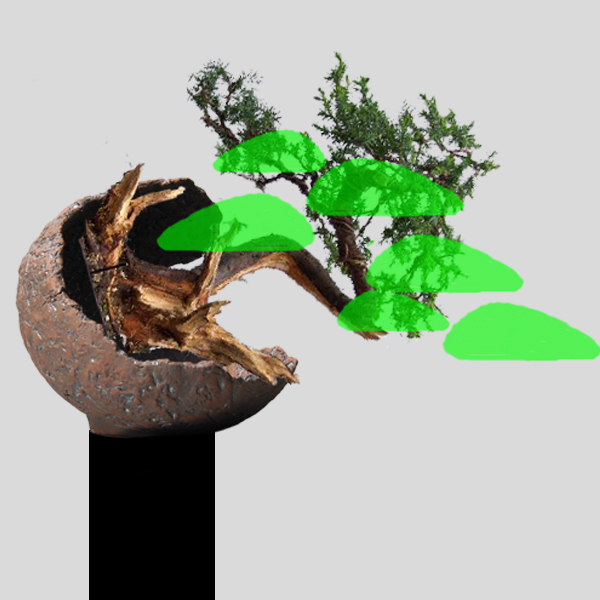
Best regards
Martin
This really is a nice tree with a lot of options. I personally dont like the momentary upright position of it. The green looks fine.....the deadwood looks fine....but both are to far away from eachother and the trunk is to thin.
A closer inspection of the roots may show another option.
So....what do you think about a kaskade?

Best regards
Martin

Klaudia & Martin- Member
 Re: Hairpin Juniper
Re: Hairpin Juniper
Hi Dave... at the risk of being succinct, you have nailed it my friend. 
I think you and I need to share a beer
I think you and I need to share a beer
Guest- Guest
 Re: Hairpin Juniper
Re: Hairpin Juniper
Tony wrote:Hi Dave... I think you and I need to share a beer
Dave: for goodness sake don't let him near the whisky!!!
Anyway, for those who are talking photo fronts vs all round viewpoints, I am trying to post some 360s of the tree but am getting nowhere which is strange as it usually works for me.
When I can get the system to upload the pics please let me know what you think

fiona- Member
 Re: Hairpin Juniper
Re: Hairpin Juniper
The 360 shots of the hairpin juni as requested before the photoflop at the weekend.
The issue was whether a tree is better when it has all-round viewing rather that one "photo front".
Comments welcome but bear in mind the foliage is under-developed as is the branch structure. I'm also aware the shari needs some work - this is happening at a further carving workshop in a fortnight's time.
current front

current rear (was originally to be the front)
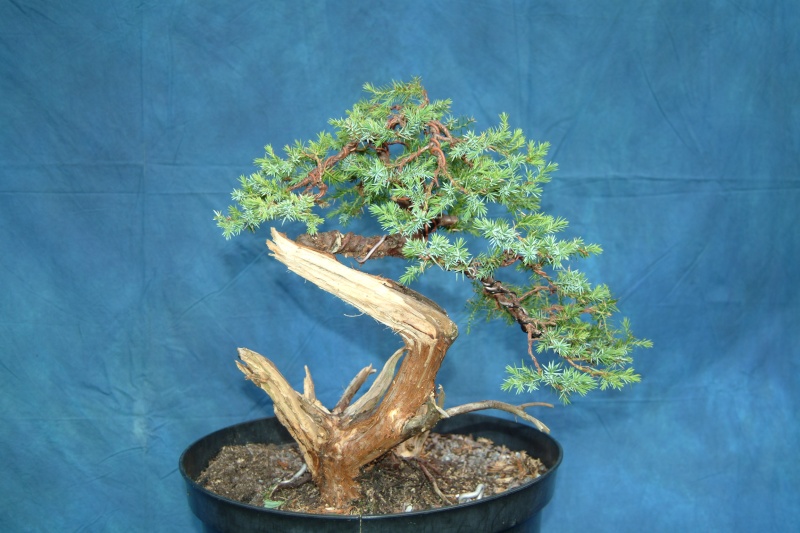
side 1
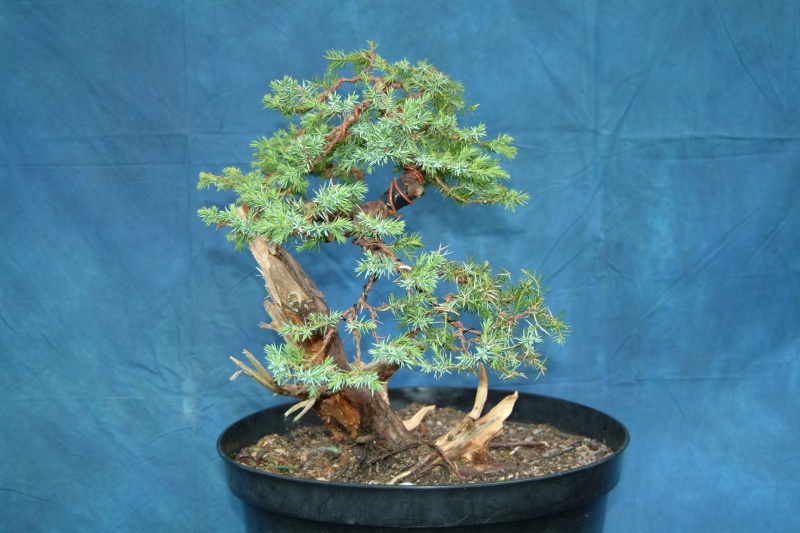
side 2

The issue was whether a tree is better when it has all-round viewing rather that one "photo front".
Comments welcome but bear in mind the foliage is under-developed as is the branch structure. I'm also aware the shari needs some work - this is happening at a further carving workshop in a fortnight's time.
current front

current rear (was originally to be the front)

side 1

side 2


fiona- Member
 Singing from the same song sheet
Singing from the same song sheet
Hi Guys,
I’ve been reading this thread with interest as it just about sums up my Bonsai career to date.
Fiona
Great tree BTW
Your years of working on “rubbish” seems to mirror my hobby so far. I did buy good material, which unfortunately got stolen, and with the onset of a young family I had to make do with what I could find cheaply or have donated from my dad’s garden. Since joining a Club I’m fast realising that most of my material is just that and will never really amount to much. That said I have been lucky with a couple of little gems but the bulk of the trees I own are becoming training/learning material. It is a good way to try new things and some have positive results that I hope to use on trees with more going for them as Bonsai.
Tony
Your advice is spot on when it comes to travelling around venues and not relying on books. I’ve visited 4 shows this year, both large and small, and have attended 1 workshop so far this year with the big one (for me) at Burrs in November. This has really opened my eyes to the world of little trees. It has made me look at what I’m doing in a different way and helped me understand what makes a good tree as opposed to a great tree. As for the “tea & biscuits” break at our Club Stone Monkey and I (along with maybe one other) tend to plan our next jaunt out or “play” with some material that we have brought along rather than feet up shooting the breeze. I must say hooking up with someone with a passion for Bonsai that has a wealth of experience has been the best thing that could happen to me even if we do disagree over the odd pot or two!!
In closing I would like to say that Forums such as this are a great help to us beginners but there is no substitute for getting out and seeing the “real” Bonsai world along with learning from respected Clubs and Bonsai artists. Many thanks to everyone that has helpped me this year, either electronically or in person, and I hope to be able to post a picture of one of my "proper bonsai" in the not too distant
I’ve been reading this thread with interest as it just about sums up my Bonsai career to date.
Fiona
Great tree BTW
Your years of working on “rubbish” seems to mirror my hobby so far. I did buy good material, which unfortunately got stolen, and with the onset of a young family I had to make do with what I could find cheaply or have donated from my dad’s garden. Since joining a Club I’m fast realising that most of my material is just that and will never really amount to much. That said I have been lucky with a couple of little gems but the bulk of the trees I own are becoming training/learning material. It is a good way to try new things and some have positive results that I hope to use on trees with more going for them as Bonsai.
Tony
Your advice is spot on when it comes to travelling around venues and not relying on books. I’ve visited 4 shows this year, both large and small, and have attended 1 workshop so far this year with the big one (for me) at Burrs in November. This has really opened my eyes to the world of little trees. It has made me look at what I’m doing in a different way and helped me understand what makes a good tree as opposed to a great tree. As for the “tea & biscuits” break at our Club Stone Monkey and I (along with maybe one other) tend to plan our next jaunt out or “play” with some material that we have brought along rather than feet up shooting the breeze. I must say hooking up with someone with a passion for Bonsai that has a wealth of experience has been the best thing that could happen to me even if we do disagree over the odd pot or two!!
In closing I would like to say that Forums such as this are a great help to us beginners but there is no substitute for getting out and seeing the “real” Bonsai world along with learning from respected Clubs and Bonsai artists. Many thanks to everyone that has helpped me this year, either electronically or in person, and I hope to be able to post a picture of one of my "proper bonsai" in the not too distant


bonsai monkey- Member
 Re: Hairpin Juniper
Re: Hairpin Juniper
Fiona,
I really do like this tree. It's got a lot of potential to develop into something quite nice.
What I was saying previously about the perspective of the lens is really well borne out here. If you look at your lowest main branch, I'm betting it's got a very nice curve when viewed from the top, looking down (as you would when positioning it). If you look at two of the side views, you'll notice it's rather straight when viewed from both the side and end-on (moreso when looking at it from "behind" the branch than looking at it through the foliage pad - if that makes sense). A little vertical movement and more horizontal movement *might* be in order. I say "might", because that's what two views from the camera show and not what's in front of me. With that being said, the rest of the foliage is well distributed and once it's filled out over the next couple seasons, along with the refinement you mention, this should give a very pleasing image regardless of the side you're looking at it from!
Thank you for putting up those images .. very enjoyable!
Kindest~
-d
I really do like this tree. It's got a lot of potential to develop into something quite nice.
What I was saying previously about the perspective of the lens is really well borne out here. If you look at your lowest main branch, I'm betting it's got a very nice curve when viewed from the top, looking down (as you would when positioning it). If you look at two of the side views, you'll notice it's rather straight when viewed from both the side and end-on (moreso when looking at it from "behind" the branch than looking at it through the foliage pad - if that makes sense). A little vertical movement and more horizontal movement *might* be in order. I say "might", because that's what two views from the camera show and not what's in front of me. With that being said, the rest of the foliage is well distributed and once it's filled out over the next couple seasons, along with the refinement you mention, this should give a very pleasing image regardless of the side you're looking at it from!
Thank you for putting up those images .. very enjoyable!
Kindest~
-d
DaveP- Member
 Similar topics
Similar topics» Little Juniper
» My new CA Juniper
» Help with a big juniper
» My new Juniper - first style
» Juniperus chinensis blauww since 2010
» My new CA Juniper
» Help with a big juniper
» My new Juniper - first style
» Juniperus chinensis blauww since 2010
Page 1 of 1
Permissions in this forum:
You cannot reply to topics in this forum







